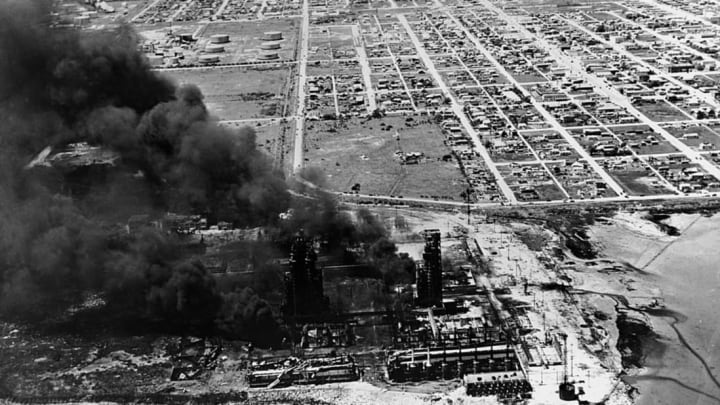The deadliest industrial disaster in U.S. history occurred on April 16, 1947, in Texas City, Texas. When the French ship SS Grandcamp exploded, a thousand buildings were destroyed and hundreds of people were killed. Among the dead were half the firefighters in the Texas City Fire Department. All of their firefighting equipment was destroyed, too, which made the city more vulnerable to the damage of the second explosion.
U.S. Federal Government via Wikimedia Commons // Public Domain
Texas City, located on Galveston Bay, was founded in 1893 by a group of investors who dredged a channel for ships and built a railroad connection between the bay and two major railway lines. The town became a major shipping port where oil companies also built refineries, and soon other industries moved in to take advantage of the port. The city grew even faster during World War II, when wartime production and shipping of materials went into overdrive. Soon, the U.S. government established War Department ordnance plants in the city to produce ammonium nitrate, widely used in explosives, especially as an oxidizer. Ammonium nitrate is also an effective fertilizer, and the factories switched over to fertilizer production after the war. But the dangers of storing and transporting large amounts of ammonium nitrate weren’t widely understood at that time—a dearth of knowledge that would have deadly consequences for Texas City.
A MASSIVE BLAST
Getty Images
On April 11, 1947, the cargo ship SS Grandcamp arrived in Texas City to pick up a load of ammonium nitrate. Rain delayed the loading process, but by April 16, the ship held around 2300 tons of the fertilizer. When longshoremen arrived to load more, they noticed a fire that seemed to be coming from several layers down in the piles of 100-pound sacks. An official from the Grandcamp didn’t want to use water on the fire because that would damage the cargo, but fed steam into the hull instead. This did nothing to extinguish the fire, though—ammonium nitrate produces its own oxygen. So the fire department was summoned, and 27 of the 47 volunteers of the Texas City Fire Department responded, with all four of the department’s trucks.
At 9:12 a.m., the ship’s cargo exploded with such force that it broke windows in Houston, 40 miles away, and was felt 250 miles away in Louisiana. The blast killed all of the firemen, the Grandcamp crew members who were still aboard, and most of the crowd that had gathered to watch the fire. Around a thousand buildings were destroyed, including warehouses at the dock and the nearby Monsanto plant, where 145 workers were killed from the explosion and the resulting 15-foot tsunami. Parts of the ship, some weighing several tons, were propelled high into the air, and metal rained down over the city. Falling shrapnel caused nearby refineries to catch fire. Two sightseeing planes flying overhead were blasted out of the air. The Grandcamp’s 2-ton anchor was blown a mile and a half away, and the only other two ships at port, the High Flyer and the Wilson B. Keene, were also damaged in the explosion; the High Flyer was torn from its mooring and thrown into the Wilson B. Keene.
Courtesy of Special Collections, University of Houston Libraries, Wikimedia Commons // Public Domain
The town’s three medical clinics—which were also damaged in the blast—were immediately overwhelmed with wounded people. Emergency personnel from Galveston and other towns came to tend to the wounded and search for survivors trapped under rubble. Fred Dowdy, the assistant fire chief and one of the few firemen left in the city, coordinated firefighters responding from elsewhere; the remaining 20 volunteer firefighters would soon be killed trying to save the city, wiping out the entire volunteer firefighting force. The local high school was pressed into service as a temporary morgue.
But the disaster was far from over. About an hour after the explosion, the crew of the High Flyer abandoned ship to escape thick smoke. No one discovered the fire in the hold—where a load of ammonium nitrate sat—until later that afternoon. Tugboats arrived to pull the High Flyer away from the dock, but the ship was stuck against the Wilson B. Keene, and at 1:10 a.m. on April 17, the High Flyer exploded. While almost everyone had been evacuated from the docks by then, the explosion sparked more fires in the city, and the Wilson B. Keene was destroyed.
THE AFTERMATH
Getty Images
The number of deaths attributed to the disaster varies. Many bodies were completely destroyed, and some seamen, undocumented workers, and travelers may not have been reported missing, but it's generally assumed that nearly 600 people were killed in Texas City, and thousands more were wounded. Property damage was estimated at around $100 million, more than a billion dollars in current value.
On June 22, a funeral was held for all of the unidentified victims. Sixty-three caskets were driven from Camp Wallace, a Navy base in Galveston County, in separate hearses from 51 funeral homes in 28 towns. Over 5000 people attended the service.
The citizens of Texas City rebuilt their town, and many of the industries rebuilt facilities there as well. A class-action lawsuit against the U.S. government, which was responsible for the ammonium nitrate, was appealed all the way up to the Supreme Court. The Court ultimately found the government not liable for the deaths. Since then, regulations regarding the transport and handling of ammonium nitrate have been enacted.
